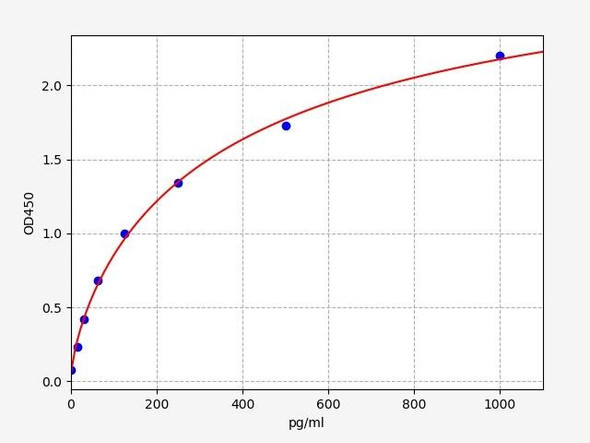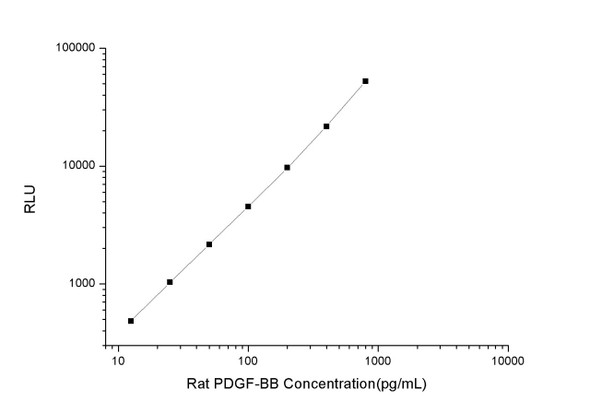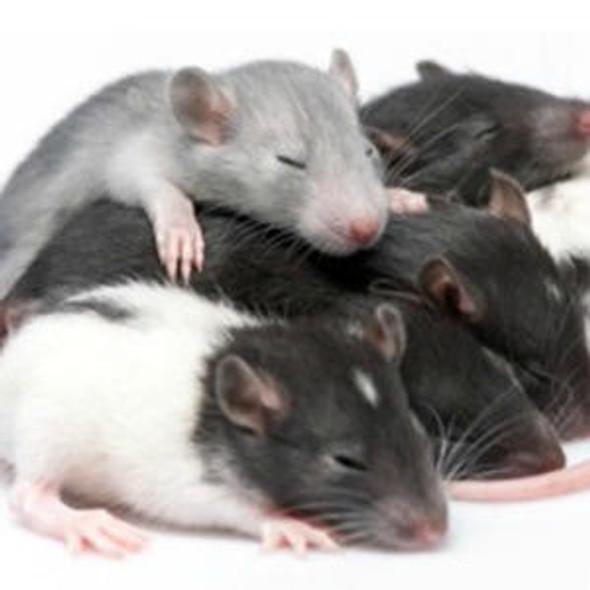Rat Signaling ELISA Kits 3
Rat PDGF-C (Platelet Derived Growth Factor C) CLIA Kit (RTES00450)
- SKU:
- RTES00450
- Product Type:
- ELISA Kit
- ELISA Type:
- CLIA Kit
- Size:
- 96 Assays
- Sensitivity:
- 4.69pg/mL
- Range:
- 7.81-500pg/mL
- ELISA Type:
- Sandwich
- Reactivity:
- Rat
- Sample Type:
- Serum, plasma and other biological fluids
- Research Area:
- Cell Biology
Description
| Assay type: | Sandwich |
| Format: | 96T |
| Assay time: | 4.5h |
| Reactivity: | Rat |
| Detection method: | Chemiluminescence |
| Detection range: | 7.81-500 pg/mL |
| Sensitivity: | 4.69 pg/mL |
| Sample volume: | 100µL |
| Sample type: | Serum, plasma and other biological fluids |
| Repeatability: | CV < 15% |
| Specificity: | This kit recognizes Rat PDGF-C in samples. No significant cross-reactivity or interference between Rat PDGF-C and analogues was observed. |
This kit uses Sandwich-CLIA as the method. The micro CLIA plate provided in this kit has been pre-coated with an antibody specific to Rat PDGF-C. Standards or samples are added to the appropriate micro CLIA plate wells and combined with the specific antibody. Then a biotinylated detection antibody specific for Rat PDGF-C and Avidin-Horseradish Peroxidase (HRP) conjugate are added to each micro plate well successively and incubated. Free components are washed away. The substrate solution is added to each well. Only those wells that contain Rat PDGF-C, biotinylated detection antibody and Avidin-HRP conjugate will appear fluorescence. The Relative light unit (RLU) value is measured spectrophotometrically by the Chemiluminescence immunoassay analyzer. The RLU value is positively associated with the concentration of Rat PDGF-C. The concentration of Rat PDGF-C in the samples can be calculated by comparing the RLU of the samples to the standard curve.
| UniProt Protein Function: | PDGFC: Growth factor that plays an essential role in the regulation of embryonic development, cell proliferation, cell migration, survival and chemotaxis. Potent mitogen and chemoattractant for cells of mesenchymal origin. Required for normal skeleton formation during embryonic development, especially for normal development of the craniofacial skeleton and for normal development of the palate. Required for normal skin morphogenesis during embryonic development. Plays an important role in wound healing, where it appears to be involved in three stages: inflammation, proliferation and remodeling. Plays an important role in angiogenesis and blood vessel development. Involved in fibrotic processes, in which transformation of interstitial fibroblasts into myofibroblasts plus collagen deposition occurs. The CUB domain has mitogenic activity in coronary artery smooth muscle cells, suggesting a role beyond the maintenance of the latency of the PDGF domain. In the nucleus, PDGFC seems to have additional function. Belongs to the PDGF/VEGF growth factor family. 3 isoforms of the human protein are produced by alternative splicing. |
| UniProt Protein Details: | Protein type:Secreted, signal peptide; Secreted Chromosomal Location of Human Ortholog: 4q32 Cellular Component: cell surface; cytoplasm; endoplasmic reticulum lumen; extracellular region; extracellular space; Golgi membrane; plasma membrane Molecular Function:platelet-derived growth factor receptor binding; protein binding; protein homodimerization activity Biological Process: blood coagulation; central nervous system development; platelet-derived growth factor receptor signaling pathway; positive regulation of cell migration; positive regulation of DNA replication; positive regulation of fibroblast proliferation; positive regulation of MAP kinase activity; positive regulation of phosphoinositide 3-kinase cascade; positive regulation of protein amino acid autophosphorylation |
| NCBI Summary: | The protein encoded by this gene is a member of the platelet-derived growth factor family. The four members of this family are mitogenic factors for cells of mesenchymal origin and are characterized by a core motif of eight cysteines. This gene product appears to form only homodimers. It differs from the platelet-derived growth factor alpha and beta polypeptides in having an unusual N-terminal domain, the CUB domain. Alternatively spliced transcript variants have been found for this gene. [provided by RefSeq, Sep 2010] |
| UniProt Code: | Q9NRA1 |
| NCBI GenInfo Identifier: | 205830662 |
| NCBI Gene ID: | 56034 |
| NCBI Accession: | Q9NRA1. 2 |
| UniProt Secondary Accession: | Q9NRA1,Q4W5M9, Q9UL22, B4DU34, B9EGR8, |
| UniProt Related Accession: | Q9NRA1 |
| Molecular Weight: | 20,609 Da |
| NCBI Full Name: | Platelet-derived growth factor C |
| NCBI Synonym Full Names: | platelet derived growth factor C |
| NCBI Official Symbol: | PDGFC |
| NCBI Official Synonym Symbols: | SCDGF; FALLOTEIN |
| NCBI Protein Information: | platelet-derived growth factor C |
| UniProt Protein Name: | Platelet-derived growth factor C |
| UniProt Synonym Protein Names: | Fallotein; Spinal cord-derived growth factor; SCDGF |
| Protein Family: | Platelet-derived growth factor |
| UniProt Gene Name: | PDGFC |
| UniProt Entry Name: | PDGFC_HUMAN |
As the RLU values of the standard curve may vary according to the conditions of the actual assay performance (e. g. operator, pipetting technique, washing technique or temperature effects), the operator should establish a standard curve for each test. Typical standard curve and data is provided below for reference only.
| Concentration (pg/mL) | RLU | Average | Corrected |
| 500 | 46590 56484 | 51537 | 51508 |
| 250 | 19942 22054 | 20998 | 20969 |
| 125 | 9978 8814 | 9396 | 9367 |
| 62.5 | 4276 4748 | 4512 | 4483 |
| 31.25 | 2418 2180 | 2299 | 2270 |
| 15.63 | 1338 1162 | 1250 | 1221 |
| 7.81 | 696 784 | 740 | 711 |
| 0 | 28 30 | 29 | -- |
Precision
Intra-assay Precision (Precision within an assay): 3 samples with low, mid range and high level Rat PDGF-C were tested 20 times on one plate, respectively.
Inter-assay Precision (Precision between assays): 3 samples with low, mid range and high level Rat PDGF-C were tested on 3 different plates, 20 replicates in each plate.
| Intra-assay Precision | Inter-assay Precision | |||||
| Sample | 1 | 2 | 3 | 1 | 2 | 3 |
| n | 20 | 20 | 20 | 20 | 20 | 20 |
| Mean (pg/mL) | 25.56 | 73.83 | 212.22 | 25.25 | 66.48 | 198.07 |
| Standard deviation | 2.16 | 7.64 | 16.66 | 2.51 | 5.32 | 19.77 |
| C V (%) | 8.45 | 10.35 | 7.85 | 9.94 | 8.00 | 9.98 |
Recovery
The recovery of Rat PDGF-C spiked at three different levels in samples throughout the range of the assay was evaluated in various matrices.
| Sample Type | Range (%) | Average Recovery (%) |
| Serum (n=5) | 95-107 | 101 |
| EDTA plasma (n=5) | 87-103 | 94 |
| Cell culture media (n=5) | 100-113 | 107 |
Linearity
Samples were spiked with high concentrations of Rat PDGF-C and diluted with Reference Standard & Sample Diluent to produce samples with values within the range of the assay.
| Serum (n=5) | EDTA plasma (n=5) | Cell culture media (n=5) | ||
| 1:2 | Range (%) | 99-114 | 99-114 | 98-114 |
| Average (%) | 107 | 106 | 105 | |
| 1:4 | Range (%) | 91-105 | 96-113 | 86-97 |
| Average (%) | 98 | 104 | 91 | |
| 1:8 | Range (%) | 99-115 | 101-112 | 89-104 |
| Average (%) | 106 | 107 | 96 | |
| 1:16 | Range (%) | 99-113 | 85-98 | 100-115 |
| Average (%) | 105 | 92 | 107 |
An unopened kit can be stored at 4°C for 1 month. If the kit is not used within 1 month, store the items separately according to the following conditions once the kit is received.
| Item | Specifications | Storage |
| Micro CLIA Plate(Dismountable) | 8 wells ×12 strips | -20°C, 6 months |
| Reference Standard | 2 vials | |
| Concentrated Biotinylated Detection Ab (100×) | 1 vial, 120 µL | |
| Concentrated HRP Conjugate (100×) | 1 vial, 120 µL | -20°C(shading light), 6 months |
| Reference Standard & Sample Diluent | 1 vial, 20 mL | 4°C, 6 months |
| Biotinylated Detection Ab Diluent | 1 vial, 14 mL | |
| HRP Conjugate Diluent | 1 vial, 14 mL | |
| Concentrated Wash Buffer (25×) | 1 vial, 30 mL | |
| Substrate Reagent A | 1 vial, 5 mL | 4°C (shading light) |
| Substrate Reagent B | 1 vial, 5 mL | 4°C (shading light) |
| Plate Sealer | 5 pieces | |
| Product Description | 1 copy | |
| Certificate of Analysis | 1 copy |
- Set standard, test sample and control (zero) wells on the pre-coated plate and record theirpositions. It is recommended to measure each standard and sample in duplicate. Note: addall solutions to the bottom of the plate wells while avoiding contact with the well walls. Ensuresolutions do not foam when adding to the wells.
- Aliquot 100 µL of standard solutions into the standard wells.
- Add 100 µL of Sample / Standard dilution buffer into the control (zero) well.
- Add 100 µL of properly diluted sample (serum, plasma, tissue homogenates and otherbiological fluids. ) into test sample wells.
- Cover the plate with the sealer provided in the kit and incubate for 90 min at 37 °C.
- Aspirate the liquid from each well, do not wash. Immediately add 100 µL of BiotinylatedDetection Ab working solution to each well. Cover the plate with a plate seal and gently mix. Incubate for 1 hour at 37 °C.
- Aspirate or decant the solution from the plate and add 350 µL of wash buffer to each welland incubate for 1-2 minutes at room temperature. Aspirate the solution from each well andclap the plate on absorbent filter paper to dry. Repeat this process 3 times. Note: a microplatewasher can be used in this step and other wash steps.
- Add 100 µL of HRP Conjugate working solution to each well. Cover with a plate seal andincubate for 30 min at 37 °C.
- Aspirate or decant the solution from each well. Repeat the wash process for five times asconducted in step 7.
- Add 100 µL of Substrate mixture solution to each well. Cover with a new plate seal andincubate for no more than 5 min at 37 °C. Protect the plate from light.
- Determine the RLU value of each well immediately.






